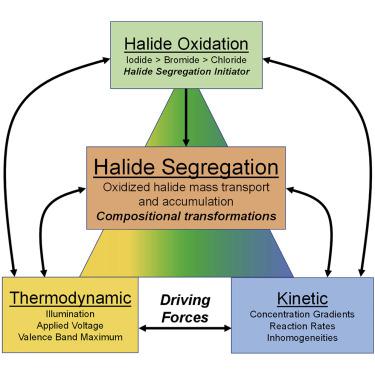Joule ( IF 38.6 ) Pub Date : 2021-08-11 , DOI: 10.1016/j.joule.2021.07.011 Ross A. Kerner 1, 2 , Zhaojian Xu 1 , Bryon W. Larson 2 , Barry P. Rand 1, 3

|
Halide perovskites display full solid solubility for Br:I and Cl:Br compositions at equilibrium, yet initially homogeneous distributions often partition into Br- and I-rich (Cl- and Br-) regions under non-equilibrium conditions (e.g., illumination), imposing a major obstacle to operationally stable bandgap tunability critical for applications such as tandem photovoltaics and light emitting diodes. Halide oxidation plays a major role in the physical demixing of alloyed halide compositions in perovskite films; this step appears to initiate halide segregation, ultimately directed by several underlying thermodynamic and kinetic driving forces operating in both concert and competition. Notably, the potential energy needed to oxidize the halide, determined by their relative oxidation potentials (I− < Br− < Cl−), can be supplied by applied voltage or illumination biases; segregation will be dictated by the most easily oxidized species leading to concentration gradients in oxidized halide products. In this perspective, we critically analyze the behaviors of halide segregation predicted by such a model capable of rationalizing a wide variety of reported observations with only photoelectrochemical halide oxidation as a commonality. The fundamental and interdisciplinary concepts invoked here clarify the role of photoelectrochemistry in halide segregation, linking illumination- and voltage-induced phenomena, and suggest that these instabilities are rooted at an atomic orbital level because of coordination environment. The path to overcome these instabilities should be paved through highly collaborative efforts, especially between material engineers and inorganic chemists to carefully manipulate dynamic disorder, macro-, and microstrains.
中文翻译:

卤化物氧化在钙钛矿卤化物相分离中的作用
卤化物钙钛矿在平衡时对 Br:I 和 Cl:Br 组合物显示出完全的固溶度,但最初的均匀分布通常在非平衡条件下(例如,光照)分配到富含 Br 和 I(Cl- 和 Br-)的区域,对串联光伏和发光二极管等应用至关重要的操作稳定带隙可调性施加了主要障碍。卤化物氧化在钙钛矿薄膜中合金卤化物成分的物理分层中起主要作用;这一步似乎引发了卤化物分离,最终由几个潜在的热力学和动力学驱动力引导,在协同和竞争中起作用。值得注意的是,氧化卤化物所需的势能取决于它们的相对氧化电位(I - < Br− < 氯−),可由外加电压或照明偏置提供;偏析将由最容易氧化的物质决定,导致氧化卤化物产品的浓度梯度。从这个角度来看,我们批判性地分析了由这种模型预测的卤化物偏析行为,该模型能够合理化各种报告的观察结果,仅将光电化学卤化物氧化作为共性。这里引用的基本和跨学科概念阐明了光电化学在卤化物分离中的作用,将光照和电压引起的现象联系起来,并表明由于配位环境,这些不稳定性植根于原子轨道水平。克服这些不稳定性的道路应该通过高度协作的努力铺平,











































 京公网安备 11010802027423号
京公网安备 11010802027423号